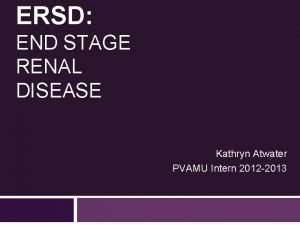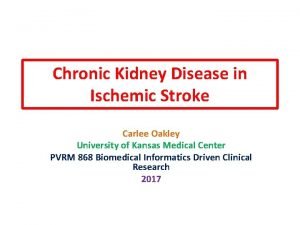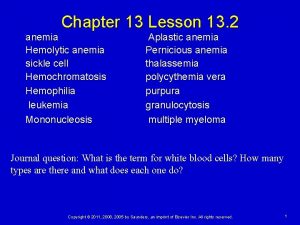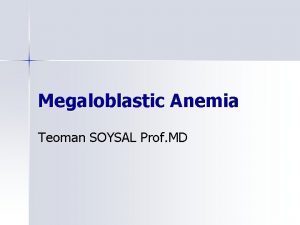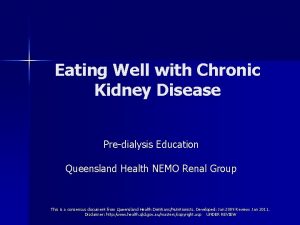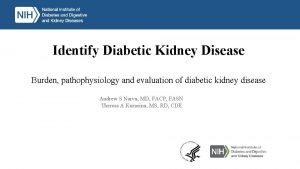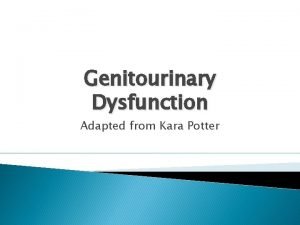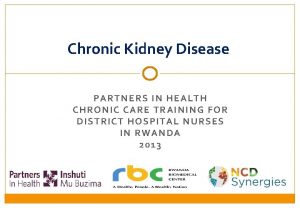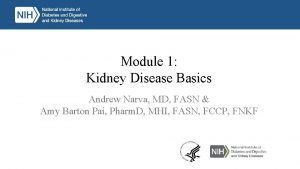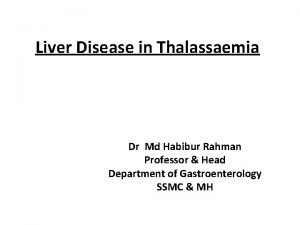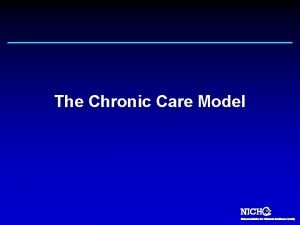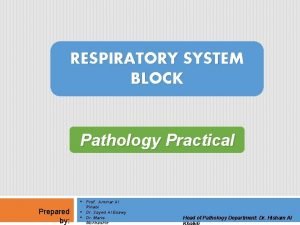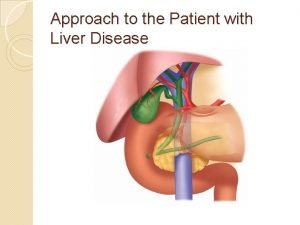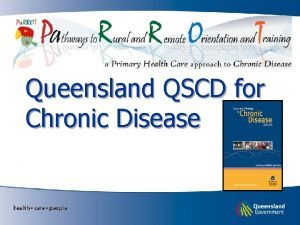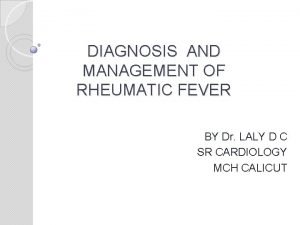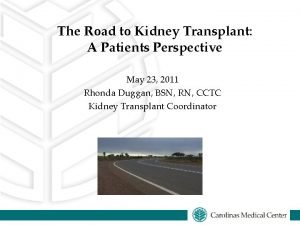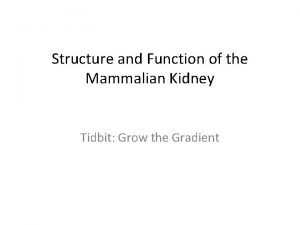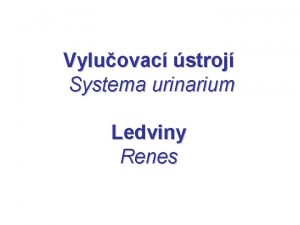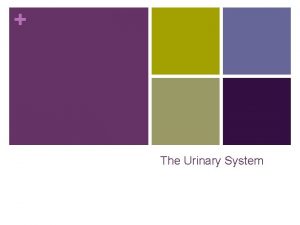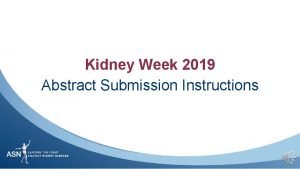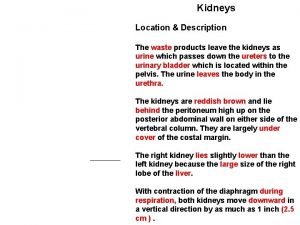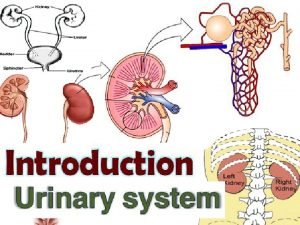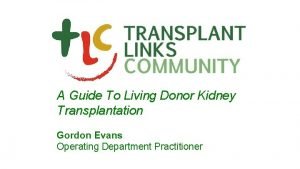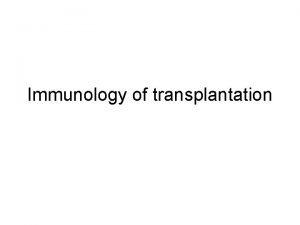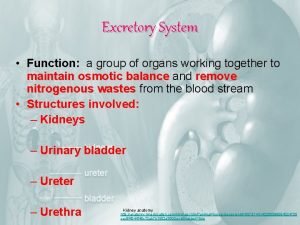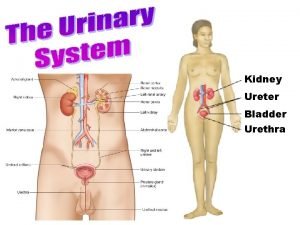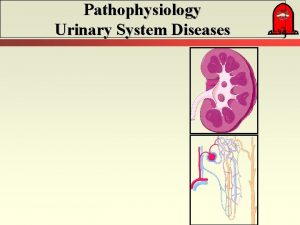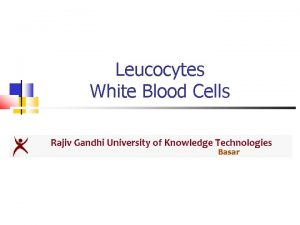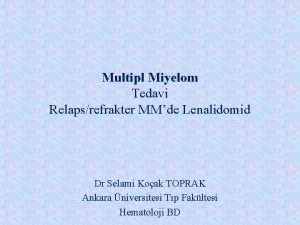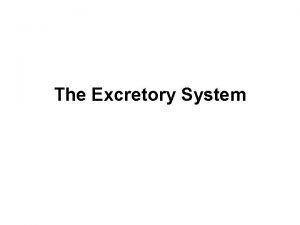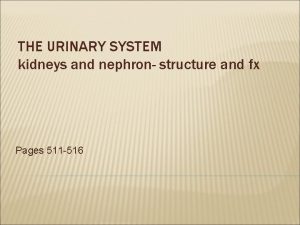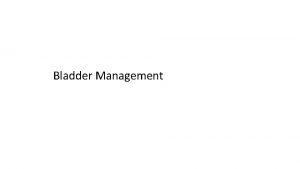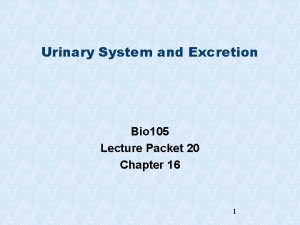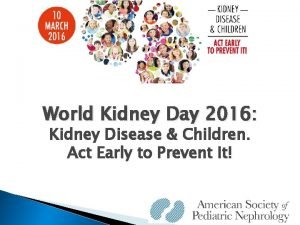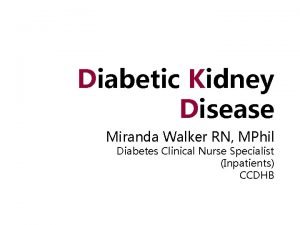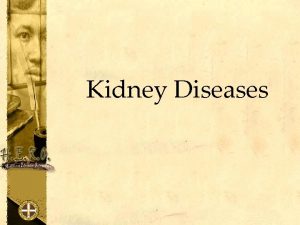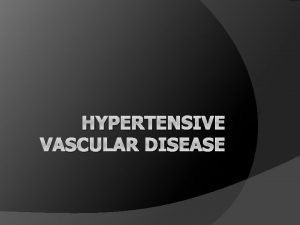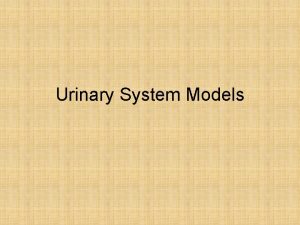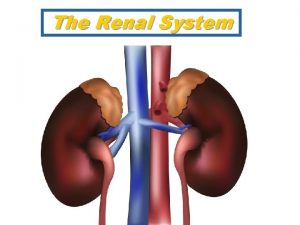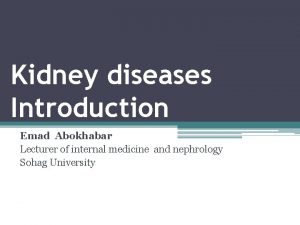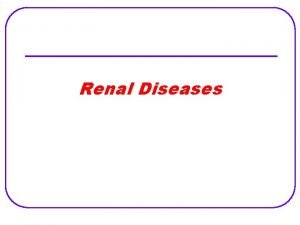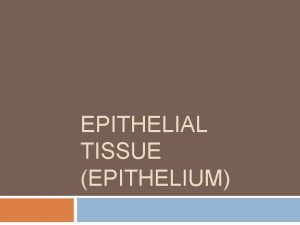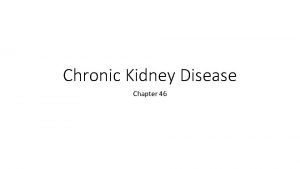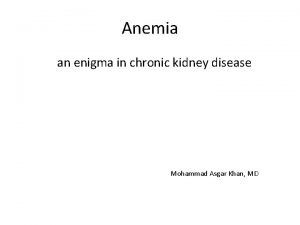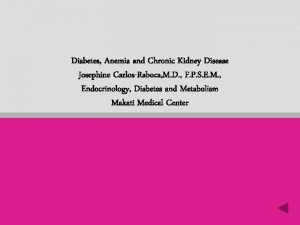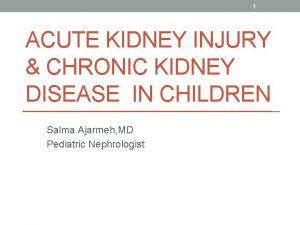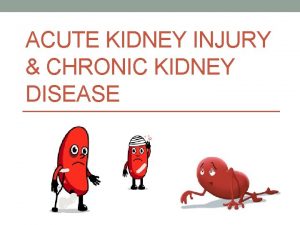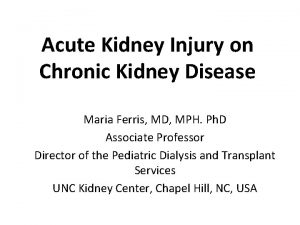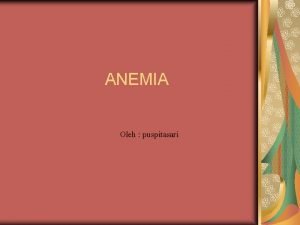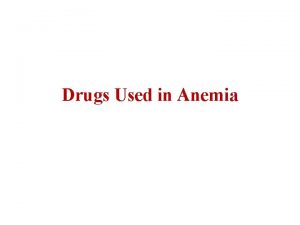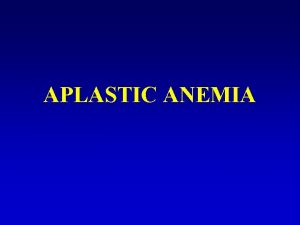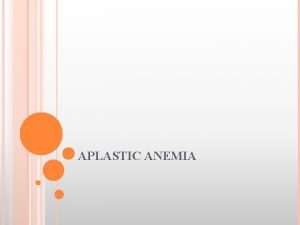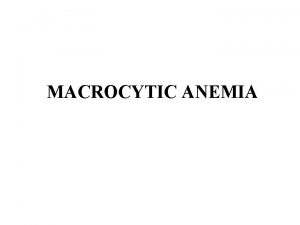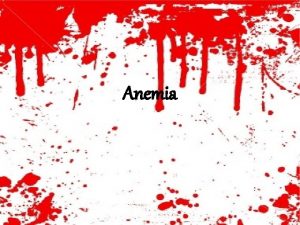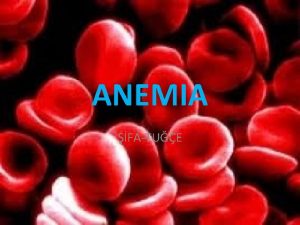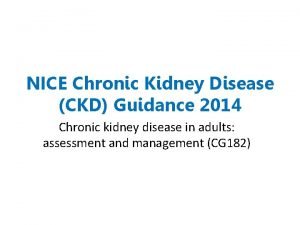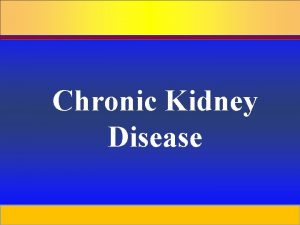Module 3 Anemia in Chronic Kidney Disease Andrew





































































- Slides: 69

Module 3: Anemia in Chronic Kidney Disease Andrew Narva, MD, FASN & Amy Barton Pai, Pharm. D, MHI, FASN, FCCP, FNKF

Faculty Disclosure Information Andrew Narva, MD, FASN No financial disclosures/conflicts of interest Amy Barton Pai, Pharm. D, MHI, FASN, FCCP, FNKF Disclosure: Consultant for Keryx Slide 2 of 68

About NKDEP This professional development opportunity was created by the National Kidney Disease Education Program (NKDEP), an initiative of the National Institute of Diabetes and Digestive and Kidney Diseases of the National Institutes of Health. With the goal of reducing the burden of chronic kidney disease (CKD), especially among communities most impacted by the disease, NKDEP works in collaboration with a range of government, nonprofit, and health care organizations to: • • raise awareness among people at risk for CKD about the need for testing; educate people with CKD about how to manage their disease; provide information, training, and tools to help health care providers better detect and treat CKD; and support health system change to facilitate effective CKD detection and management. To learn more about NKDEP, please visit: http: //www. nkdep. nih. gov. For additional materials from NIDDK, please visit: http: //www. niddk. nih. gov. Slide 3 of 68

Meet our Presenters Amy Barton Pai, Pharm. D, MHI, FASN, FCCP, FNKF Dr. Barton Pai is Chair of the National Kidney Disease Education Program’s Pharmacy Working Group Dr. Amy Barton Pai, Pharm. D. , MHI, FASN, FCCP, FNKF is Associate Professor of Clinical Pharmacy at the University of Michigan College of Pharmacy. She obtained her Bachelor of Science in Pharmacy from Albany College of Pharmacy in 1996 and then completed a Pharmacy Practice Residency at St. Peter’s Hospital in Albany, New York. She received her Doctor of Pharmacy from Albany College of Pharmacy in 1999. From 1999 -2001 she was a Nephrology Research Fellow at the University of Illinois at Chicago. Dr. Pai was on faculty at the University of New Mexico College of Pharmacy and School of Medicine from 2001 to 2008 and at Albany College of Pharmacy and Health Sciences from 2008 to 2016. She earned a Master's degree in Healthcare Innovation in 2018. Slide 4 of 68

Meet our Presenters Andrew S. Narva, M. D. , F. A. C. P. Dr. Narva is the Director of the National Kidney Disease Education Program (NKDEP) at the National Institutes of Health. Prior to joining the NKDEP in 2006, he served as Director of the Kidney Disease Program for the Indian Health Service (IHS). Dr. Narva continues to serve as the Chief Clinical Consultant for Nephrology for IHS and to provide care for patients at Zuni Pueblo through a telemedicine clinic. Dr. Narva is a member of the American Board of Internal Medicine Nephrology Subspecialty Board. He has served as a member of the Eighth Joint National Committee (JNC 8) Expert Panel, the National Quality Forum Renal Steering Committee, the Kidney Disease Outcomes Quality Initiative Work Group on Diabetes in Chronic Kidney Disease, and the Medical Review Board of End Stage Renal Disease Network 15. Slide 5 of 68

After completing this module, you will be able to: • Describe applications of erythropoiesis and iron metabolism in treating anemia of CKD and the role of the pharmacist in addressing current controversies in care. • Discuss how laboratory, clinical, and medication data are used to assess and monitor anemia in chronic kidney disease (CKD) and identify optimal management strategies. • Review the key differences in formulation, pharmacokinetics, pharmacodynamics and immunogenicity between the available intravenous iron products. • Integrate the evidence-base for erythropoiesis stimulating agents (ESA) into care paradigms for different CKD settings (e. g. pre-dialysis vs. transplant) Slide 6 of 68

Anemia is a complication of CKD Anemia may: • • Result from inadequate erythropoietin synthesis. Develop early and worsen as CKD progresses. Occur earlier in people with diabetes. Involve inadequate iron intake, impaired iron absorption and chronic inflammation. Slide 7 of 68

Anemia may develop as e. GFR declines NHANES 2007 -2010 Reference: Adapted from Stauffer PLo. S ONE 2014 Slide 8 of 68

Kidneys act as oxygen sensors in the body • Renal tissue hypoxia triggers erythropoietin production. • Erythropoietin stimulates erythrocyte (red blood cell) synthesis in bone marrow. • Hemoglobin is the primary iron-containing protein in erythrocytes that transports and delivers oxygen to tissues. • Both erythropoietin and iron are required to produce hemoglobin (Hgb) and correct hypoxia. Slide 9 of 68

Red Blood Cell Cycle Slide 10 of 68

Anemia in CKD Erythropoietin (EPO) production/ Decreased responsiveness to EPO GI absorption of iron Iron demands Anemia of CKD Inflammation/infection ( hepcidin) Blood loss (phlebotomy, dialysis) Erythrocyte half-life Poor nutrition Slide 11 of 68

Question A 66 year old patient with an e. GFR of 20 m. L/min/1. 73 m 2 presents with symptoms of anemia. The patient has been taking ferrous sulfate orally and currently has a diabetic foot infection being treated with antibiotics. Which of the following is likely contributing to the patient’s anemia? a) b) c) d) Decrease in EPO production Decrease in iron absorption in GI tract Infection All of the above Slide 12 of 68

Answer A 66 year old patient with an e. GFR of 20 m. L/min/1. 73 m 2 presents with symptoms of anemia. The patient has been taking ferrous sulfate orally and currently has a diabetic foot infection being treated with antibiotics. Which of the following is likely contributing to the patient’s anemia? a) b) c) d) Decrease in EPO production Decrease in iron absorption in GI tract Infection All of the above Slide 13 of 68 Answer: D Anemia in CKD is often multi-factorial. The principal cause of anemia in CKD is decreased EPO production but, in this patient decreased iron absorption in GI tract and current infection are also contributors.

Iron transport & storage are dysregulated in CKD Reference: http: //www. cdc. gov/ncbddd/hemochromatosis/training/pathophysiology/iron_cycle_popup. htm Slide 14 of 68

Additional factors for inadequate iron in CKD • Both a spontaneous decrease in intake and aversion to foods with protein may occur as e. GFR declines. • Hepcidin may accumulate in CKD. § Hepcidin is the hormone that controls iron homeostasis. § This hormone regulates iron absorption in the gut and mobilization of stored iron. • Inflammation may reduce absorption of iron. References: Kopple et al. Kidney Int 2000; 57(4): 1688– 1703; Young et al. Clin J Am Soc Nephrol 2009; 4(8): 1384– 1387. Slide 15 of 68

Hepcidin-Master iron regulator • Iron regulates hepcidin; increased iron levels stimulates hepcidin production • Increased erythropoietin activity reduces hepcidin levels • Inflammation and infection increases hepcidin synthesis • Hepcidin inhibits iron release from macrophages as well as intestinal iron absorption. Slide 16 of 68

Anemia in CKD is associated with morbidity and mortality Observational data show association with: • Coronary artery disease • Left ventricular hypertrophy • Hospitalization for cardiac disease • Death from congestive heart failure • All-cause mortality Toto. Kidney Int 2003; 64(suppl 87): S 20–S 23. Slide 17 of 68

Question Which of the following is a possible cause of anemia in chronic kidney disease patients? a) Increased GI iron absorption b) Decreased erythropoietin synthesis c) Increased red blood cell life span d) Decreased inflammation Slide 18 of 68

Answer Which of the following is a possible cause of anemia in chronic kidney disease patients? a) Increased GI iron absorption b) Decreased erythropoietin synthesis c) Increased red blood cell life span d) Decreased inflammation Slide 19 of 68 Answer: B As kidney function declines, the kidney becomes unable to produce adequate erythropoietin and poor erythropoiesis is compounded by reduced iron absorption. Answer C and D are incorrect because red blood cell life span decreases and systemic inflammation typically increases in patients with CKD.

USING LABORATORY DATA TO GUIDE CKD MANAGEMENT Slide 20 of 68

How do we know if the patient has anemia? • Diagnosis of anemia § Hemoglobin § Males: Hb <13 g/d. L § Females: Hb <12 g/d. L § Additional workup § § § § CBC RBC indices Ferritin Transferrin saturation (TSAT) Stool screen for occult blood Serum folate Vitamin B 12 Slide 21 of 68

Symptoms and Signs Symptoms • • • Fatigue Dizziness ↓ exercise tolerance Shortness of breath Weakness • • Palpitations Vertigo Pica (with iron deficiency) Irritability Signs • Tachycardia • Pale appearance • ↓ mental acuity • Neurological symptoms (with vitamin B 12 deficiency) Slide 22 of 68

Assessing iron status • Serum iron § Measures ferric iron (Fe 3+), subject diurnal variation • Total iron-binding capacity (TIBC) § TIBC measures the amount of iron binding sites available on serum transferrin. • Transferrin saturation (TSAT) § § Generally reflects iron available for transport to the bone marrow Calculated as serum iron/TIBC x 100 = TSAT • Serum ferritin § Ferritin in the liver reflects stored iron, however, serum ferritin may not be as robust in reflecting stored iron § Acute phase reactant and will be elevated in acute & chronic inflammation http: //www. cdc. gov/nutritionreport/report. html Slide 23 of 68

Laboratory for healthy adults Healthy Adult Male Healthy Adult Female Range Hemoglobin >13. 0 g/d. L >12. 0 g/d. L 12. 0 – 18. 0 g/d. L Serum Iron 65 – 177 ug/d. L 50 – 170 ug/d. L 50 – 177 ug/d. L Serum Ferritin 18 – 270 ng/m. L 18 – 160 ng/m. L 18 – 270 ng/m. L Suggested laboratory targets to initiate iron supplementation in CKD patients Parameter KDIGO (2012) ND-CKD HD-CKD TSAT <30% Serum ferritin ≤ 500 ng/m. L Slide 24 of 68

Hemoglobin target is controversial: Boxed Warning for ESAs Chronic Kidney Disease: • In controlled trials, patients experienced greater risks for death, serious adverse cardiovascular reactions, and stroke when administered erythropoiesis-stimulating agents (ESAs) to target a hemoglobin level of greater than 11 g/d. L (5. 1). • No trial has identified a hemoglobin target level, ESA dose, or dosing strategy that does not increase these risks (2. 2). • Use the lowest ESA dose sufficient to reduce the need for red blood cell (RBC) transfusions (5. 1). Slide 25 of 68

Case The patient is a 68 year-old male (95 kg, BMI 31 kg/m 2) with CKD and a history of diabetes for several years. He is a chronic smoker referred for management of anemia. He is currently on furosemide 40 mg BID, metoprolol tartrate 50 mg BID, aspirin 81 mg once daily, and insulin glargine 15 units in the morning. His pertinent labs include: e. GFR Hgb Serum ferritin TSAT 25 ml/min/1. 73 m 2 9. 2 110 ng/ml 21% Slide 26 of 68

Question His anemia is likely due to: a) b) c) d) Iron deficiency Folate/vitamin B 12 deficiency Reduced erythropoietin production A and C Slide 27 of 68

Answer His anemia is likely due to: a) b) c) d) Iron deficiency Folate/vitamin B 12 deficiency Reduced erythropoietin production A and C Slide 28 of 68 Answer: D Answer A is correct because the patient is iron deficient (TSAT <30%, Ferritin <500 ng/m. L). Answer B is incorrect does not have laboratory data to support B 12 or folate deficiency. Answer C is correct because patient has advanced kidney disease (e. GFR 25).

IRON THERAPY Slide 29 of 68

Treatment Goal • Goals § § Reduce blood transfusion requirements Minimize hospitalizations Decrease signs and symptoms of anemia Improve quality of life • Treatment Approaches § Typically utilizes the combination of iron therapy and erythropoiesis stimulating agents (ESA) Slide 30 of 68

Iron Therapy (KDIGO recommendations) • Goal: TSAT<30% and ferritin <500 ng/m. L • CKD patients with anemia not on iron § Increase in hemoglobin without starting ESA desired • CKD non-dialysis patients (ND) § 1 -3 months of oral iron § Choice of route should be chosen based on severity of iron deficiency, ongoing blood losses, iron status tests, Hgb concentration, ESA responsiveness, ESA dose and clinical statu • Hemodialysis patients (HD) • Trial of IV iron Slide 31 of 68

Amount of elemental iron differs between oral iron supplements • Absorption: Ferrous+2 iron > ferric+3 iron • A 325 mg dose of: § Ferrous fumarate has 108 mg elemental iron (33%). § Ferrous sulfate has 65 mg elemental iron (20%). § Ferrous gluconate has 35 mg elemental iron (12%). Reference: http: //www. anemia. org A Physician’s Guide to Oral Iron Supplementation. Nov 2008. Slide 32 of 68

What needs to be considered before starting oral iron? Use of Oral Iron Pros • • • No IV access needed Orally absorbed (regulated) Convenient Inexpensive Utilizes normal iron physiology pathways therefore avoiding potential safety changes with IV iron Cons • GI adverse effects common (nausea, constipation, diarrhea) • Poor tolerability and adherence common • Limited bioavailability of most oral iron preparations • Food reduces iron absorption (need acidic gastric p. H) • Takes months to replete iron stores • Darkens stools, may mask GI bleeding Slide 33 of 68

Tips on oral iron supplements Impaired absorption with: • • • Caffeinated beverages (especially tea) Calcium (foods and beverages, supplements) Antacids H-2 receptor blockers Proton pump inhibitors Consider: • Start with half of the recommended dose, gradually increase. • Take with food. • Try different preparation. • Take in divided doses. • Stool softener may help. Reference: http: //www. anemia. org A Physician’s Guide to Oral Iron Supplementation. Nov 2008. Slide 34 of 68

Take iron supplement separate from calcium-based phosphate binders • Calcium supplements may be prescribed with meals to bind dietary phosphorus. § Calcium may interfere with iron absorption. • Indications of when to take iron supplements: § Iron absorption is increased when supplement is taken between meals and separate from phosphate binders. Slide 35 of 68

IV Iron may be used in CKD patients • Five formulations available in the US • IV iron formulations are nanoparticle suspensions comprised of iron oxide cores with carbohydrate shells Bound Transferrin § Limits free iron plasma, thus reducing toxicity § Metabolized via reticuloendothelial system n atio i c (i. e. macrophage phagocytosis) isso D n Iro § There are unresolved potential bioavailability and safety challenges Phagocytosis (related to labile iron) with IV iron formulations Iron-Carbohydrate Complex Free Iron Oxidative Damage (Iron released to circulation) Macrophages (RES) (Iron Storage) Zager, Clin J Am Soc Nephrol 2006; 1(suppl 1): S 24–S 31. Charytan et al CJASN 2015 Slide 36 of 68

What do I need to consider before starting IV Iron? Use of IV Iron Pros Cons • Does not require absorption from • Requires patient to come to clinic for GI tract several infusions • Increase iron stores and • Some formulations associated with availability faster than oral anaphylactoid reactions preparations • Bioavailability from RES not well-studied • Long-term safety and different dosing regimens for IV iron formulations has not been studied in a randomized controlled trial in CKD • Expensive Zager et al. Kidney Int 2004; 66(1): 144– 156; Zager, Clin J Am Soc Nephrol 2006; 1 (suppl 1): S 24–S 31; Hörl, J Am Soc Nephrol 2007; 18(2): 382– 393; Charytan DM, et al. J Am Soc Nephrol. 2015 Jun; 26(6): 1238 -47; Macdougall IC et al. Kidney Int. 2016 Jan; 89(1): 28 -39 Slide 37 of 68

IV Iron Formulations Drug Brand Name Molecular Weight (MW) Usual Adult Dose ++ Ferrlecit + HD: 125 mg elemental iron over 10 minutes per HD session; Most require cumulative dose of 1 g over eight HD sessions for a favorable response 62. 5 -1000 Iron sucrose Venofer + HD: 100 mg over 2 -5 minutes during consecutive dialysis sessions (10 doses) NON-HD: 200 mg over 2 -5 minutes on five different occasions within 14 days (total dose 1, 000 mg) 25 -1000 Hypertension, nausea, muscle cramps, headaches, upper respiratory infection, edema, dizziness Ferumoxytol Feraheme +++ 510 mg over in 50 -200 m. L NS or D 5 over 15 min, Observe patient for 30 minutes after infusion A second 510 mg dose can be given 3 -8 days later 510 mg BOXED WARNING: Anaphylaxis, Hypotension, flushing, itching Diarrhea, constipation, dizziness, hypotension, peripheral edema Ferric carboxymaltose Injectafer +++ ≥ 50 kg: 750 mg IV followed by 750 mg 7 days later <50 kg: 15 mg/kg IV followed by 15 mg/kg 7 days later 750 mg Hypertension, flushing, itching, decreased phosphate level, nausea, headache Sodium ferric gluconate 25 -1000 Common Adverse Events INFe. D (low MW) Dexferrum (high MW) Iron dextran 100 mg over 2 minutes (25 mg test dose required) Dose Ranges (mg) Test dose: 0. 5 m. L (25 mg) and observe for 1 hour Sodium ferric gluconate complex (generic) Slide 38 of 68 BOXED WARNING: Anaphylactic reactions (requires test dose) Pain and brown staining at injection site, flushing, hypotension, fever, chills, myalgia Hypotension, hypertension, headache, dizziness, nausea, vomiting , diarrhea

Question A patient with CKD was recently diagnosed with iron deficiency anemia. The provider wants to start her on a intravenous iron product. Which of the intravenous iron products requires a test dose? a. b. c. d. e. Ferumoxytol Iron Dextran Iron Sucrose Sodium Ferric Gluconate Ferric Carboxymaltose Slide 39 of 68

Answer A patient with CKD was recently diagnosed with iron deficiency anemia. The provider wants to start her on a intravenous iron product. Which of the intravenous iron products requires a test dose? a. b. c. d. e. Ferumoxytol Iron Dextran Iron Sucrose Sodium Ferric Gluconate Ferric Carboxymaltose Slide 40 of 68 Answer: B Iron dextran requires a test dose because of documented anaphylactoid reactions. Ferumoxytol also has a boxed warning about hypersensitivity, however no test dose is required, infusion over at least 15 minutes is recommended with a minimum of 30 minutes of observation post infusion

Considerations for IV iron administration when inflammation is present • Administered dose of elemental iron is not able to be fully utilized (incorporated into RBCs) • Clearance of IV iron compounds is ZERO-ORDER (capacity-limited, saturable) • Clearance decreases as molecular weight increases Slide 41 of 68

Question Which of the following is true regarding IV iron formulations? a) b) c) d) Their pharmacokinetic profiles are well-characterized They are all colloidal suspensions of nanoparticles The proportion of the elemental iron dose incorporated into RBCs is required by the FDA in the new drug application All of the above Slide 42 of 68

Answer Which of the following is true regarding IV iron formulations? a) b) c) d) Their pharmacokinetic profiles are well-characterized They are all colloidal suspensions of nanoparticles The proportion of the elemental iron dose incorporated into RBCs is required by the FDA in the new drug application Answer: B All of the above All FDA approved IV iron formulations are iron oxide-carbohydrate nanoparticles in colloidal suspension. Slide 43 of 68

Zero order pharmacokinetic profile of ferumoxytol Plasma ferumoxytol log concentration vs. time curve Pai AB et al. Clin Pharmacol Ther 2010 Aug; 88(2): 237 -42 Slide 44 of 68

The more IV iron, the better? Coyne DW et al. J Am Soc Nephrol 2007; 18: 975; Kapoian T et al. J Am Soc Nephrol 2008; `9; 372; Spiegel G, Chertow G. Clin J Am Soc Nephrol 2009; 41009 Slide 45 of 68

Comparison of catalytically active iron among available products Sodium Ferric Gluconate (SFG) Iron concentration (μg/m. L-1) Dose equivalent (mg) Mean (± SD) BDI (μg/m. L-1) Iron Sucrose LMW Iron (IS) Dextran (ID) Ferumoxytol (FMX) 42 (n=5) 168 (n=2) 125 125 500 0. 41 ± 0. 15 0. 37 ± 0. 10 0. 17 ± 0. 05 0. 06 ± 0. 03 0. 28 ± 0. 10 Slide 46 of 68

Generic IV Iron Formulations • Sodium ferric gluconate is the only US generic • Iron Sucrose: Widely available in Europe, South America and Asia • Referred to as “similars” • Less expensive and considered equivalent to Venofer® • Switches are often mandated in Europe • European Medicines Agency suggests the terminology “Non-biological Complex Drugs” http: //www. ema. europa. eu/ema/, www. fda. gov/GDUFAReg. Science Slide 47 of 68

Laboratory Parameters Before and After Switching to an Iron Sucrose Similar Rottembourg J et al Nephrol Dial Transplant. 2011 Oct; 26(10): 3262 -7 Slide 48 of 68

Summary • CKD patients can be treated with oral or IV iron therapy. • Dialysis patients are usually treated with IV iron therapy. • There are gaps in knowledge regarding pharmacokinetics, pharmacodynamics and outcomes related to IV iron administration in CKD. • Clinical iron indices may be insufficient for the clinician to adequately evaluate iron storage and availability and should be used in the context of the individual patients response. • Judicious use of IV iron formulations is warranted until more prospective data clarify long-term safety and efficacy. Slide 49 of 68

TREATING ANEMIA WITH ERYTHROPOIESIS STIMULATING AGENTS Slide 50 of 68

Erythropoietin Stimulating Agents (ESA) • Genetically engineered forms of erythropoietin • Biological so only dosed parenterally • Must advise patient of risks and benefits • Recombinant EPO first available in 1989 to treat anemia in end-stage renal disease (ESRD) § Prior to availability, patients often symptomatic with Hemoglobin (Hb) in 6 -7 g/d. L range http: //www. fda. gov/drugsafety/postmarketdrugsafetyinformationforpatientsandproviders/ucm 200297. htm Slide 51 of 68

ESA Drug Epoetin alfa Darbepoetin alfa Methoxy polyethylene Glycol -epoetin beta Brand Name Epogen Procrit Aranesp Mircera Starting Dose in Adults Routes Half-Life (h) 50 -100 units/kg once weekly or every 2 weeks (ND-CKD) 50 -100 units/kg one to three times per week (HD) IV or SQ 8. 5 (IV)/ 24 (SQ) 0. 45 mcg/kg once every 4 weeks (ND-CKD) 0. 45 mcg/kg once per week or 0. 75 mcg/kg every 2 weeks (HD) 0. 6 mcg/kg SQ or IV once every 2 weeks (ND-CKD or HD) Slide 52 of 68 IV or SQ 25 (IV)/ 48 (SQ) IV or SQ 134 (IV)/ 139 (SQ)

Dosing Conversion for ESAs Epoetin alfa dose (units/week) Darbepoetin alfa dose (mcg/week) Methoxy Polyethylene Glycol-Epoetin Beta < 8, 000 <40 120 mcg IV/SQ once a month or 60 mcg IV/SQ every 2 weeks 8, 000 to 16, 000 40 -80 200 mcg IV/SQ once a month or 100 mcg IV/SQ every 2 weeks >16, 000 >80 360 mcg IV/SQ once a month or 180 mcg IV/SQ every 2 weeks Package Insert. Mircera. Slide 53 of 68

Case Question A 58 year old male (185 lb) currently receiving thrice weekly dialysis and 75 units/kg of epoetin alfa three times per week is being switched to darbepoetin alfa in the hospital. What is the appropriate dose of darbepoetin alfa? a)25 mcg/week b)40 mcg/week c)60 mcg/week d)100 mcg/week Slide 54 of 68

Case Answer A 58 year old male (185 lb) currently receiving thrice weekly dialysis and 75 units/kg of epoetin alfa three times per week is being switched to darbepoetin alfa in the hospital. What is the appropriate dose of darbepoetin alfa? a)25 mcg/week b)40 mcg/week c)60 mcg/week d)100 mcg/week Answer: C Patient weighs 83. 9 kg, so his weekly dose of epoetin alfa equals 12, 585 units (50 units/kg x 83. 9 kg x 3 times/week). This converts to 60 mcg/weekly of darbepoetin alfa by using the conversion table. Slide 55 of 68

ESA • Common adverse events (≥ 20%) § § § Hypertension (most common) Infection Hypotension Myalgia Nausea Diarrhea • Monitoring Parameters § Hemoglobin once weekly upon initiation of an ESA and until stable; then once monthly § Evaluate transferrin saturation and serum ferritin Slide 56 of 68

Blood transfusions are associated with many risks • Patients required frequent blood transfusions before ESA were available. • Risks associated with blood transfusions include: § § § Volume overload Iron overload Allosensitization (i. e. sensitization to donor blood) Transfusion reactions Bloodborne infection Slide 57 of 68

CHOIR Study Correction of Anemia with Epoetin Alfa in Chronic Kidney Disease (CHOIR study) • Randomized Controlled Trial • N=1432 patients with CKD stage 3 and 4 patients • Dosing of epoetin alfa targeted to achieve a Hb of 13. 5 vs 11. 3 g/d. L for an intended 36 month follow up period • Primary end point time to composite of death, MI, hospitalization for CHF or stroke • Secondary endpoints include time to RRT, hospitalization for any cause and quality of life Singh A, et al. N Engl J Med 2006; 355: 2085 -98. Slide 58 of 68

CHOIR outcome • Early termination with median follow up of 16 months • More CV events (MI, stroke, CHF hospitalization) in higher Hgb group • Similar QOL scores between the groups Hazard Ratio (95% CI) 1. 34 (1. 03 -1. 74) p=0. 03 Slide 59 of 68

CREATE Study Cardiovascular Risk Reduction by Early Anemia Treatment with Epoetin Beta • • N = 603 CKD patients (primarily stage 4) Hb 10. 5 -11. 5 g/d. L vs. 13 -15 g/d. L Primary endpoint: Composite cardiovascular events Secondary endpoint: left ventricular mass index, the progression of chronic kidney disease, and the quality of life Drueke TB, et al. N Engl J Med 2006; 355: 2071 -84. Slide 60 of 68

CREATE Outcome • No significant difference in the risk of a first cardiovascular (CV) event between the complete correction and partial correction groups (hazard ratio 0. 78; 95% CI 0. 53 -1. 14; P = 0. 20) • More frequent dialysis initiation and hypertensive episodes and headaches were more frequently reported in the higher Hb group Time to primary first CV event after censoring data of patients at the time of dialysis initiation Group 1= higher Hb Group 2= lower Hb Slide 61 of 68

TREAT Study A Trial of Darbepoetin Alfa in Type 2 Diabetes and Chronic Kidney Disease (TREAT study) • N =4038 CKD stage 3 and 4 patients with diabetes • Hgb 13 vs < 9. 0 g/d. L (placebo group with rescue darbepoetin when Hgb) • Primary endpoints: Time to the composite outcome of death or a cardiovascular event and the time to the composite outcome of death or ESRD Pfeffer M, et al. N Engl J Med 2009; 361: 2019 -32. Slide 62 of 68

TREAT outcome • No difference in primary CV composite endpoint • Higher risks of fatal/non-fatal strokes in normal Hgb group ( 5% vs 2. 6% HR 1. 92, P < 0. 001) • More patients in the rescue group required transfusions in the placebo group (496 vs 297 p<0. 001) • Patients with a history of cancer in the higher. Hb group also had a higher risk of death Slide 63 of 68

Hemoglobin in CKD: Guidelines Suggestions KDIGO (2012) ND-CKD HD-CKD If Hb ≥ 10 g/d. L do not initiate an ESA Use ESAs to avoid drop in Hb to <9 g/d. L by starting ESA when Hb is between 9 and 10 g/d. L If Hb < 10 g/d. L, consider rate of fall of Hb, prior response to iron, risk of needing a transfusion, risk of ESA therapy, and presence of anemia symptoms before initiating an ESA Do not use ESAs to maintain Hb above 11. 5 g/d. L Note: Most institutions utilize their own ESA dosing protocol with more detailed dosing changes recommended based on Hb response. Some protocols have lower and upper limits of Hb that differ from guideline suggestions. Slide 64 of 68

Question A 71 year old female presents to the CKD clinic with the following laboratory data complaining of increasing fatigue and shortness of breath. She recently received 2 doses of 100 mg of iron sucrose IV. Hb 9. 2 g/d. L; TSAT 40%; Ferritin 550 ng/m. L Which of the following is the most appropriate therapeutic intervention? a)Ferrous sulfate 325 mg PO TID b)Iron sucrose 100 mg IV X 5 doses c)Start an ESA d)No intervention necessary Slide 65 of 68

Answer A 71 year old female presents to the CKD clinic with the following laboratory data complaining of increasing fatigue and shortness of breath. She recently received 2 doses of 100 mg of iron sucrose IV. Hb 9. 2 g/d. L; TSAT 40%; Ferritin 550 ng/m. L Which of the following is the most appropriate therapeutic intervention? a)Ferrous sulfate 325 mg PO TID b)Iron sucrose 100 mg IV X 5 doses c)Start an ESA d)No intervention necessary Slide 66 of 68 Answer: C The patient’s iron indices indicate repletion and still anemic and symptomatic therefore an ESA can be initiated

Hyporesponse to anemia treatment in CKD • Decreased responsiveness to erythropoietin • Uremia • Chronic inflammation • Severe hyperparathyroidism • Folate deficiency Slide 67 of 68

Summary • ESAs should be used judiciously in CKD • Consider potential reasons for hyporesponse that may facilitate dose reductions • Doses should be individualized and the patient's clinical status desired outcomes from treatment should be integrated in goal setting Slide 68 of 68

 Ersd
Ersd Nih score
Nih score Pernicious anemia vs megaloblastic anemia
Pernicious anemia vs megaloblastic anemia Polycythemia differential diagnosis
Polycythemia differential diagnosis Megaloblastic anaemia definition
Megaloblastic anaemia definition Nemo ckd
Nemo ckd Albumin kidney disease
Albumin kidney disease Sighns of kidney problems
Sighns of kidney problems Symptomatic polycystic kidney disease
Symptomatic polycystic kidney disease Choronic kidney disease
Choronic kidney disease Albumin kidney disease
Albumin kidney disease Stigmata of chronic liver disease
Stigmata of chronic liver disease Kate lorig chronic disease self-management
Kate lorig chronic disease self-management Chronic disease
Chronic disease Jewish chronic disease hospital
Jewish chronic disease hospital Wagner chronic care model
Wagner chronic care model عکس رادیولوژی ریه سیگاری
عکس رادیولوژی ریه سیگاری Peripheral stigmata of cld
Peripheral stigmata of cld Cld chronic liver disease
Cld chronic liver disease Chronic disease
Chronic disease Chronic granulomatous disease
Chronic granulomatous disease Vijaya's echo criteria
Vijaya's echo criteria Stigmata of chronic liver disease
Stigmata of chronic liver disease Nursing management of chronic liver disease
Nursing management of chronic liver disease Bharathi viswanathan
Bharathi viswanathan C device module module 1
C device module module 1 Disadvantage of kidney transplant
Disadvantage of kidney transplant Non excretory function of kidney
Non excretory function of kidney Tubule
Tubule Kidney
Kidney Renal papilla
Renal papilla Urinary system
Urinary system Asn abstract deadline
Asn abstract deadline Infantile polycystic kidney
Infantile polycystic kidney The medial concave margin of the kidney
The medial concave margin of the kidney Retroperitoneal organs
Retroperitoneal organs Kidney donor transplant
Kidney donor transplant How does a kidney transplant work
How does a kidney transplant work Excretory system image
Excretory system image Role of urinary bladder
Role of urinary bladder Primary glomerulonephritis
Primary glomerulonephritis Histological structure of kidney
Histological structure of kidney Two types of wbc
Two types of wbc Seer kidney cancer
Seer kidney cancer A muscular bag that holds urine
A muscular bag that holds urine Figure 15-3 is a diagram of the nephron
Figure 15-3 is a diagram of the nephron Kidney in pelvis
Kidney in pelvis Pearson
Pearson Ain kidney
Ain kidney World kidney day 2011
World kidney day 2011 Midpole of the left kidney
Midpole of the left kidney Peritubular capillaries in kidney
Peritubular capillaries in kidney 7 functions of the kidney
7 functions of the kidney Basinlike area of the kidney continuous with the ureter
Basinlike area of the kidney continuous with the ureter Kidney failure and foamy urine pictures
Kidney failure and foamy urine pictures Uric acid kidney stone
Uric acid kidney stone Kidney
Kidney Flea bitten kidney
Flea bitten kidney Fish kidney
Fish kidney Pearson
Pearson Slk eligibility criteria
Slk eligibility criteria Bowmans capsule
Bowmans capsule Kidney biopsy core curriculum
Kidney biopsy core curriculum Where are the kidneys located in the body
Where are the kidneys located in the body I am happy
I am happy Chapter 15 the urinary system figure 15-3
Chapter 15 the urinary system figure 15-3 The functional unit of the kidney is the .
The functional unit of the kidney is the . Grade 11 excretion
Grade 11 excretion Juxtaglomerular apparatus function
Juxtaglomerular apparatus function Epithelial tissue
Epithelial tissue
